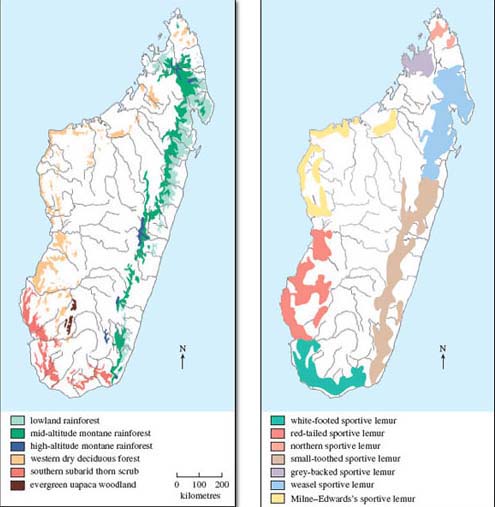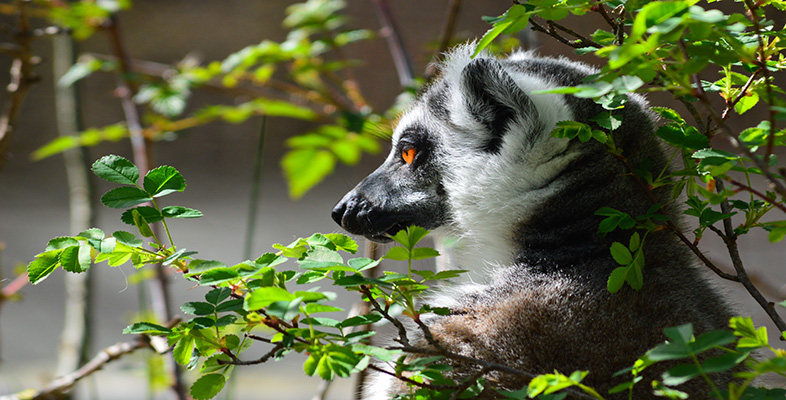5 Lemurs and their origin
5.1 Introduction
The island of Madagascar is relatively small compared to the enormous landmasses of Africa, Asia and South America inhabited by the primates I've mentioned up to now. Yet of the 250 or so living primate species, more than 30 species of lemur live in Madagascar - an astonishingly high 13 per cent or so of all primate species. Their diversity is reflected in the identification of no fewer than five families, related in the way suggested in Figure 2.
What are just as striking are the mammalian groups that are absent from Madagascar or sparsely represented - there are none of the large African herbivores, few carnivores, no rabbits or hares and no monkeys or apes; lemurs have evolved in an environment with a unique mix of fauna. All lemurs could loosely be described as tree dwellers, usually to a very marked degree, and display a correspondingly rich array of adaptations. As our knowledge increases, so does the species count of lemurs; species thought to be extinct have recently been rediscovered. Careful fieldwork has revealed subtly distinct species coexisting in what was previously thought to be a homogeneous population. Genetic evidence, e.g. numbers of chromosomes or DNA sequence comparisons, has also led to further subdivisions. If you add to the score the many lemur species that have become extinct over the past few thousand years, the total number of evolved species is close to 50.
As I've mentioned, lemurs are the only primates on Madagascar (humans apart) and their evolutionary development over the past 50 million years or so has taken place in an isolated, self-contained 'natural laboratory' of evolution. Genetic evidence has shown - more convincingly than morphological evidence is ever likely to - that lemurs are monophyletic, meaning that they are share a single common ancestor, which according to Figure 2, would have lived in the Eocene. What is striking is the subsequent 'bushiness' of the evolutionary tree, in the major part of the branch labelled strepsirhines. This proliferation of species reflects the process of adaptive radiation: over time, a single lineage has diversified into a number of evolutionary branches that occupy different niches and have a distinctive mix of adaptive features.

Quite why so many different species have evolved in a relatively small landmass isn't known for certain. It may be linked to the different climate zones on the island, each with distinctive plant species, and to the influence of many natural barriers in the form of rivers and land of very varying altitude - features that would tend to isolate populations and thereby promote the origin of new species (i.e. promote speciation). The diversity of environments Madagascar contains indeed rivals that of larger continents, though the areas of untouched vegetation are now a fraction of what they used to be, as Figure 6a implies. Much of the island nowadays is agricultural grassland. Of the original vegetation, representing the major habitats for today's lemurs, there are (montane, i.e. high altitude) rainforests in the east and deciduous forests in the north and west; in the southwestern parts of the island there is dense thorn scrubland, plus vestiges of evergreen woodland.
The enormous diversity of lemurs reflects the extraordinary scale and power of the mechanisms that drive evolution. For example, lemurs vary greatly in size; the mouse lemurs [p. 234] are tiny - indeed the pygmy mouse lemur - weighing just 30 g or so - is the smallest known primate, about the mass of a house mouse. Giant sloth lemurs are now extinct, but were in excess of 200 kg - larger than a modern-day gorilla. The variation in dental formulae amongst lemurs (and the morphology of the molar teeth) is said to be greater than in all other living primates taken together. And as you'd expect, there is considerable specialisation in lemur eating habits: some eat leaves; others, like the ring-tailed lemur [p. 240], prefer fruit. The diet of bamboo lemurs is self-evident; in fact, the three different species identified feed on different parts of the plant; for example, the golden bamboo lemur (which you will see in the next video clip) feeds just on new shoots, which contain amounts of cyanide that would be lethal to other primates. Other lemur species eat gum or small invertebrate prey. There are wide variations too in the social groupings that lemurs form, which are often different from the patterns evident in monkeys and apes. In general, group sizes in lemurs are smaller than in monkeys and apes and females tend to be the dominant sex.
Overall, lemurs are very distinctive and unusual primates. Primatologists assume that their odd features - their social groupings, less constant body temperatures, and low metabolic rate, for example, - are adaptive, i.e they increase fitness. Explaining why such adaptations are beneficial is problematic, when other primates thrive on opposite strategies. Most explanations link them with the rather frugal existence that lemurs endure on Madagascar - the climate, and therefore food supply, are unpredictable and the soils are poor. Lemur evolution seems to have been influenced very sharply by the need to maximise the use of scarce resources and the need to conserve energy.
Madagascar split away from mainland Africa in the distant past [p. 234]. The best estimates are that the process was complete by about 120 million years ago. It's likely that the first primates evolved more recently - perhaps as long as 90 million years ago, but certainly after detachment of the island. Clearly, no early lemur could have migrated overland on to what is now Madagascar; you can check from Figure 2 that lemurs originated at a much later date, when Madagascar was an island. And yet nearly all expert opinion claims that the ancestors of lemurs originated from Africa, rather than, say, what is now India, from which Madagascar finally severed its connection more recently - about 88 million years ago. So how could the ancestors of lemurs have arrived on an isolated Madagascar?
The most widely accepted explanation is that the first primates arrived by floating across from Africa on mats of drifting vegetation, perhaps 60 million or more years ago. The Mozambique Channel is more than 400 km wide, so the journey would have been a significant feat of endurance, but given the presumed monophyletic origins of lemurs, we can view it as a rare but fortuitous event.
Question 7
What attributes in these early primate 'sailors' would have increased their chances of success?
Answer
Being small and light would presumably be advantageous, helping them to stay afloat on small bits of driftwood, etc. Indeed, modern-day lemurs that most resemble ancestral forms are small - the dwarf and mouse lemurs [p. 234] - and are generally regarded as the 'best living models for ancestral primates'. You can see in Figure 2 that this group and the remaining lemur families parted evolutionary company more than 30 million years ago.
Question 8
What feature of small mammals (linked with their high metabolic rate) would be a severe disadvantage in 'rafting'?
Answer
Their high metabolic rate is reflected in their voracious appetites, prompting them, as with shrews, to spend a large proportion of their waking hours feeding.
As I've hinted already, many lemurs have a lower than expected basal metabolic rate (BMR) but torpor is prevalent too. For example, when climatic conditions are unfavourable, normally during the cool summer, dwarf and mouse lemurs can spend days in torpor - a feat that no other primate appears able to match. Indeed, days can sometimes stretch to weeks and months, with the animals reducing their metabolic rate by up to 90 per cent and lowering their body temperature close to ambient. Recent field studies have shown that these lemurs usually aggregate during torpor, in huddling groups of up to 15 in single tree-holes. Keeping each other warm in this way increases the energy saved during torpor yet further.
All these capacities have been used as evidence to support the rafting hypothesis in that it suggests a plausible mechanism for this feat of endurance. At one stage, the belief prevailed that colonisation involved 'a pop-eyed ancestral lemur clinging with all its limbs onto the wave-washed twigs of a raft of floating tree trunks or tangled branches'. Now the picture painted is of 'entire groups of animals survived the weeks or even months of such a journey without food or water, sleeping in a hollow tree while rafting across the sea'. Both are wonderfully evocative images, given the inheritance that these pioneers have left behind. Perhaps perspectives on this issue will change in the years ahead - possibly with renewed support for some of the alternative hypotheses for migration, such as island-hopping across the Channel after a temporary reduction in sea-level.
And what of human influences on lemurs? Here the tale is depressingly familiar. The first human settlers arrived in Madagascar about 2000 years ago - probably from the Malaysian/Indonesian area. By the time Europeans arrived in the country in the mid-1660s, 15 species of lemur had become extinct, amongst them the largest, most striking and bizarre, such as the sloth lemurs.
